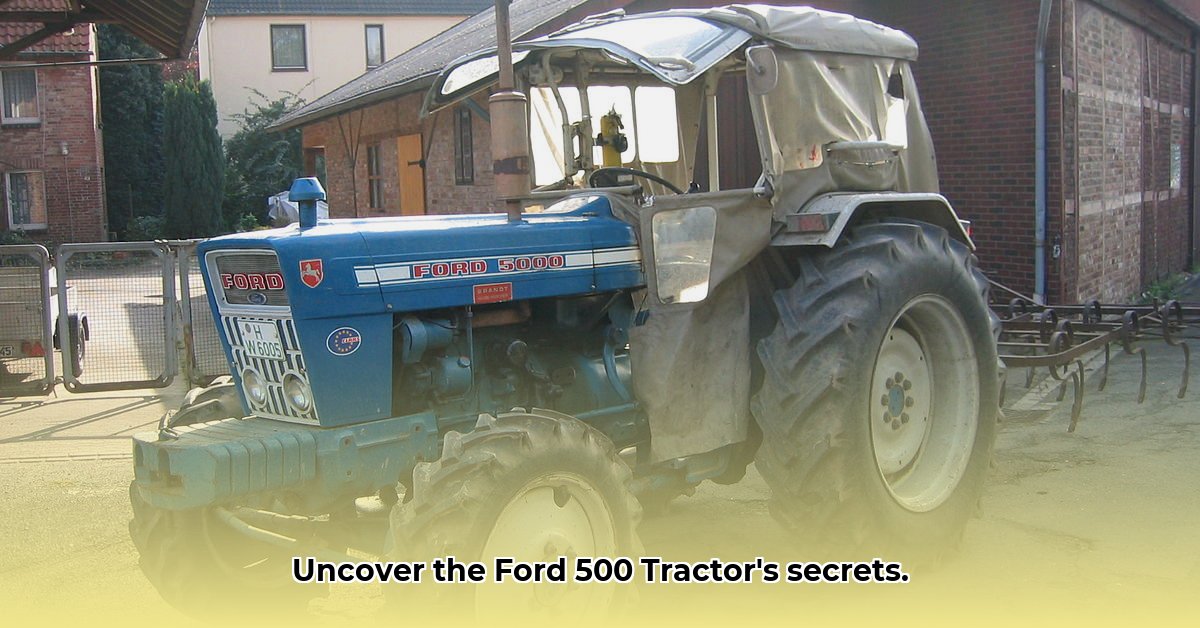
The Ford 5000 tractor, produced from 1965 to 1976, holds a significant place in agricultural history. More than just a machine, it represents a pivotal moment in farming technology, offering a compelling blend of power, versatility, and durability that solidified its reputation as a dependable workhorse. This article delves into the Ford 5000's history, specifications, and enduring appeal to collectors. For even more detailed specifications, check out this comprehensive guide.
Under the Hood: Power and Performance of the Ford 5000
The Ford 5000 typically boasted an engine generating approximately 69 horsepower, though variations exist depending on the specific model year and source. This power was channeled through a choice of transmissions: an 8-speed, a 10-speed full power shift, or a 16-speed partial power shift. This impressive range of options gave farmers unprecedented control and adaptability in various field conditions. Available in row-crop and general-purpose body styles, the Ford 5000 proved suitable for a wide array of agricultural tasks. Its power take-off (PTO) offered both 540 and 1000 RPM, maximizing compatibility with a diverse range of implements. Wasn't this flexibility a significant advantage for farmers seeking efficiency and versatility?
| Feature | Specifications | Notes |
|---|---|---|
| Engine Horsepower | Approximately 69 hp | Variations reported across different sources. |
| Transmission Options | 8-speed, 10-speed full power shift, 16-speed partial power shift | Offered farmers exceptional control and flexibility in the field. |
| Body Styles | Row-crop, General-purpose | Designed to accommodate various farming needs and terrain conditions. |
| PTO | 540/1000 RPM | Enhanced compatibility with a wide variety of implements and attachments. |
A Collector's Perspective: The Enduring Allure of the Ford 5000
The Ford 5000's enduring appeal to collectors stems from its robust construction and historical significance. Restoring one, however, is a significant undertaking requiring considerable time, expertise, and resources. Locating original parts can be challenging, as can deciphering the nuances of the various model variations produced over its decade-long production run. Yet, for many collectors, the reward—owning and preserving a piece of agricultural heritage—is immeasurable. What specific challenges do collectors face when restoring a Ford 5000, and what are the key aspects of its design which garner the most interest amongst such enthusiasts?
When considering a Ford 5000 for your collection, prioritize the engine's condition. A healthy engine is paramount to the tractor's overall functionality and value. Carefully examine the transmission; its smooth operation is crucial. Furthermore, authenticity is a key factor for serious collectors, who value the meticulous restoration of these machines to their original state.
Beyond the Specifications: The Ford 5000's Impact and Legacy
The Ford 5000 represents a significant advancement in agricultural technology, reflecting the rising demand for efficiency and productivity during its era. Its robust power, flexible configurations, and relatively manageable size made it suitable for a wide range of farming operations. The open operator station, common in tractors of its time, contrasts sharply with the enclosed cabs of modern tractors, highlighting the continuous improvements in safety and technology within the agricultural sector. While lacking the advanced features of contemporary models, the Ford 5000 remains a powerful symbol of innovation and progress. It is a testament to the engineering ingenuity of its time, and its ongoing appeal among collectors and enthusiasts signifies a lasting legacy that speaks to both technological and agricultural history.
Comparing Ford 5000 Tractor Specifications to Competitors in the 1960s
Key Takeaways:
- The Ford 5000's robust design and longevity were noteworthy for its era.
- Its adaptability, including modifications like MFWD conversions, extended its versatility and service life.
- Comparisons with 1960s competitors reveal its competitiveness in power and features, though fuel efficiency was a factor.
- The variety of models (5100, 5200, high-crop) catered to diverse farming needs, boosting efficiency.
- Early power steering challenges underline the crucial role of maintenance.
Power, Durability, and Fuel Efficiency: A Comparative Analysis
The Ford 5000's engine output, ranging from 55 to 69 horsepower, was impressive for its time. However, a direct comparison with contemporaries like the John Deere 4020 or Massey Ferguson 135 requires a deeper look at PTO and drawbar horsepower for a complete picture. While its power was competitive, its fuel efficiency, as seen through the lens of modern standards, was a noticeable limitation. But this should be viewed within the context of the overall technological landscape of the 1960s. Did the trade-off between power and fuel consumption represent a judicious compromise for farmers during that era?
The Ford 5000's reputation for durability is well-earned. Reports of exceeding 10,000 operating hours highlight its robust construction. This longevity offers an environmental advantage by reducing the need for frequent equipment replacement. Furthermore, its adaptability, exemplified by common four-wheel drive conversions, further extended its useful lifespan.
Model Variations and Maintenance: A Focus on Sustainability
The Ford 5000's various models – row-crop, utility, and high-crop – showcased its adaptability to different farming needs. This specialization, mirroring the principle of using the right tool for the job, enhanced efficiency and minimized unnecessary wear and tear. Moreover, its longevity renders proper maintenance a fundamental aspect of both operational efficiency and preservation for enthusiasts and collectors alike. The ability to maintain and repair these machines holds significant sustainable value, reducing the environmental impact through reduced waste.